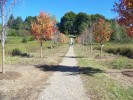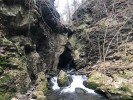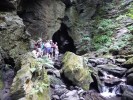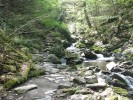The protection of Dover Stone Church was the result of the combined efforts of the DLC, the Town of Dover, the Friends of Dover Stone Church, and Dutchess County, who together raised the funds to buy and preserve the initial 58 acres in 2004. Since that time the DLC has worked with the Town to secure several additional parcels to enlarge the Preserve to today’s 174 acres, to establish a tree-lined entrance from the Village, and to implement a wonderful trail system.
Today, the Dover Stone Church Preserve is a popular local attraction, and a tourist destination spot. It is an easy walk from the Village of Dover, the local elementary school, and the Dover Plains Station of Metro North's Harlem Rail Line, with continued access north to the Harlem Valley Rail Trail.
Features of the Stone Church
- Entrance: Large metamorphic rocks converge to form the entrance in the shape of a church's cathedral window. The gothic appearance of the cave entrance gave rise to the name “Stone Church.”
- “The Pulpit:” Inside the cavern is a rock ledge, affectionately given this name by Richard Maher, a Dover Plains resident and former town clerk who wrote the book, Historic Dover in 1908.
- Stone Church Brook: The brook that flows through the Stone Church cavern is a tributary of the Ten Mile River. The Ten Mile River flows southeast and is a branch of the Housatonic River in Connecticut.
- Waterfall: Inside the cavern, there is a 30-foot waterfall cascading into a pool of water that flows through and out the cavern entrance and continues as the Stone Church Book.
Visiting the Preserve
Please take only memories, leave only footprints! Carry out your trash and obey all posted trail signs. The right of way to the preserve is through a private property. Please stay on marked trails and be respectful of all adjacent property owners. For the Dover Stone Church Preserve brochure with directions, parking, and trail map, click here.History of the Preserve
The popularity of the Stone Church dates back to the 1830s, when thousands of visitors would come see this natural phenomenon and stay in the adjacent Stone Church Hotel. The romantic nature of the Stone Church and the proximity to the hotel, made it a popular wedding site. The Stone Church captured the attention of Hudson River School artist Asher B. Durand who depicted the site in his Master Drawing in 1847. It was also the subject of a book by Benson Lossing, a local historian, entitled The Dover Stone Church.The legends that surround the Dover Stone Church date back to the 1600s and the Pequot War. Fleeing Long Island, the Chief of the Pequots, Sassacus, with six sachems, a few women (perhaps his daughter), and a bodyguard of 20 warriors fled north up the Housatonic River and west up the Ten Mile River into eastern New York with the intention of reaching Mohawk territory near Albany. Sassacus and his men took refuge in the cave of the Dover Stone Church, subsisting on the abundant fish and berries of the area.
Read more about the Pequot War >
Today, the Dover Stone Church hosts many of our education programs in this special outdoor classroom.



























